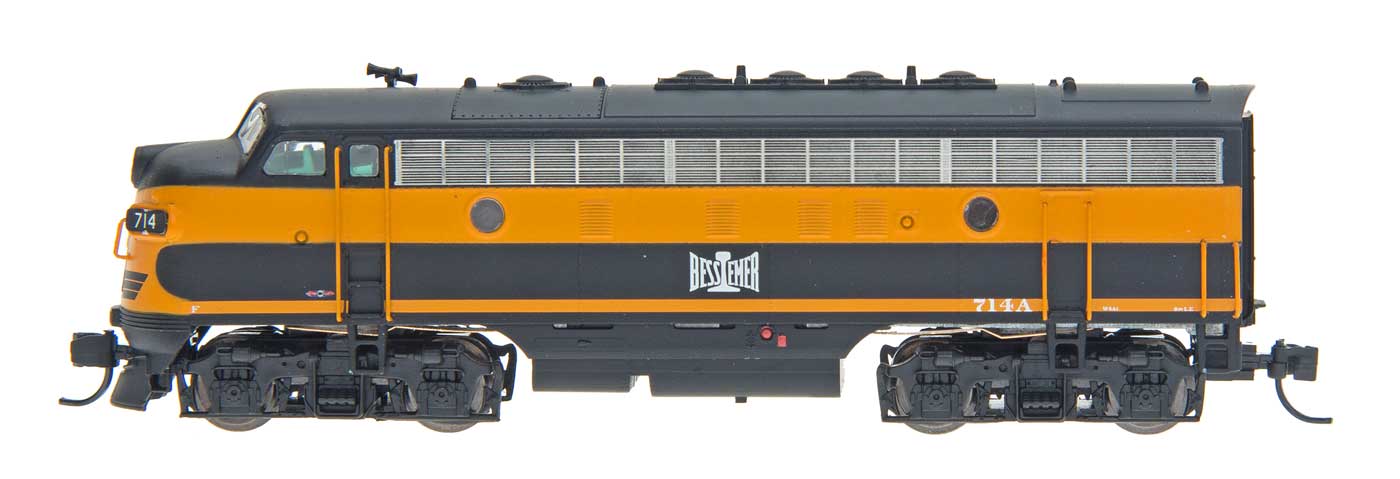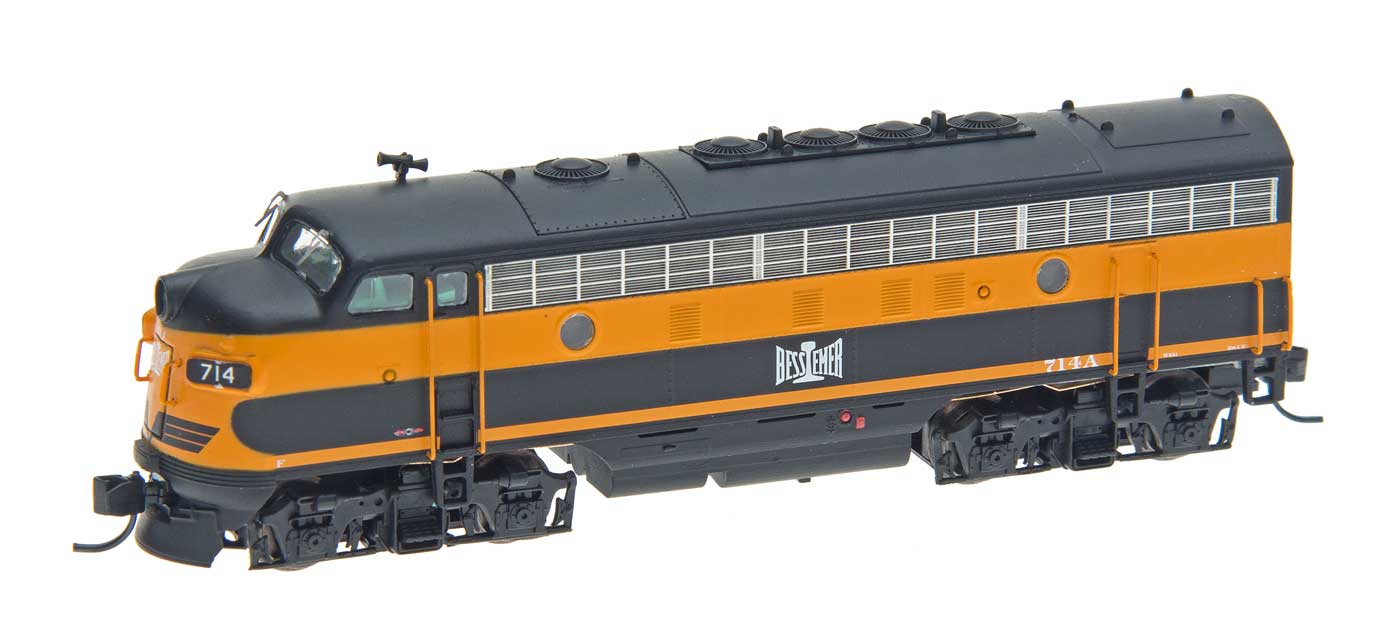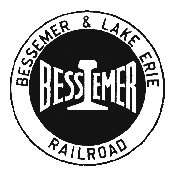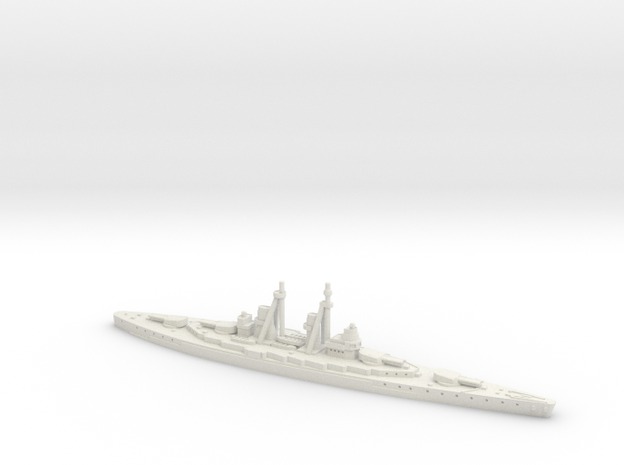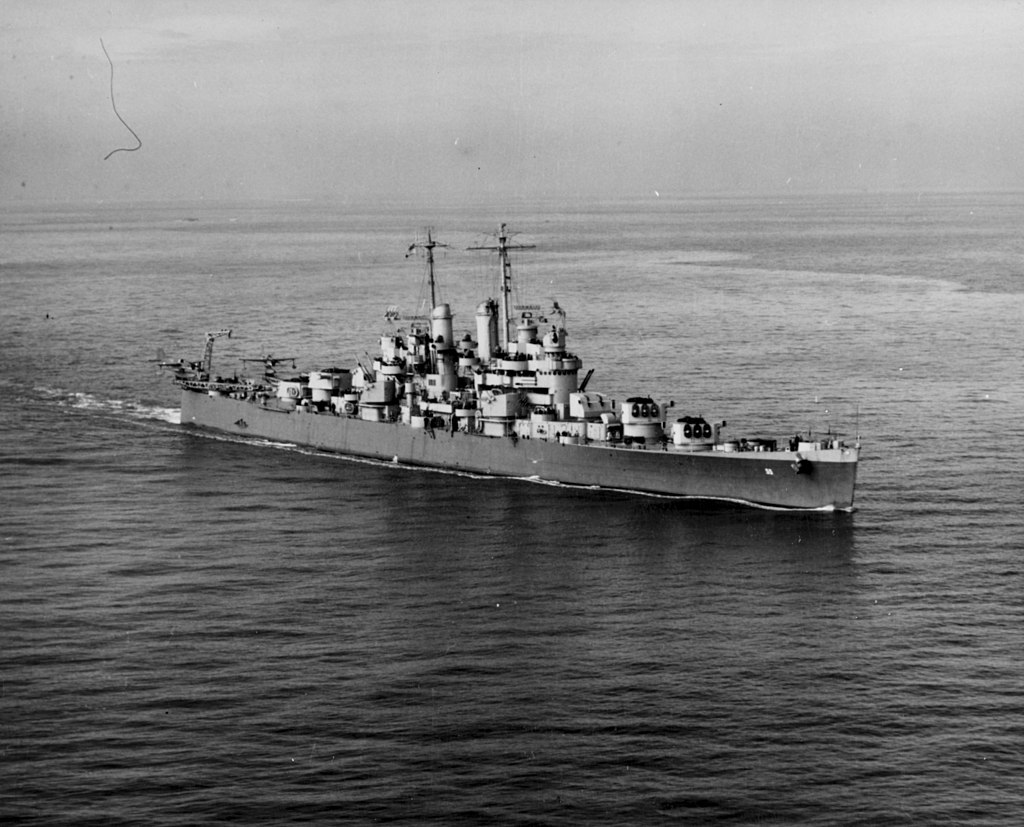Model Information:
Features of this model include (2023 run):
Features of this model include (2023 run):
- LED lighting - All lights separately controllable on DCC units.
- Upper nose MARS Light (where applicable)(single headlight units, upper nose light acts as the headlight)
- Lower Headlight (where applicable)
- Illuminated number boards
- Ditch Lights (DCC only)(No units factory equipped with ditch lights, however LEDs are provided for use by the modeler)
- Wire & Etched metal details
- Laser sharp painting and printing
- Micro-Trains compatible couplers
DCC Information:
The 2023 run is available in 3 versions:
The 2023 run is available in 3 versions:
- DC models equipped with a DC only circuit board and are DCC Ready.
- Non-Sound equipped with an ESU LokPilot 5 DCC decoder (stock number suffixed by letter D)
- Sound units equipped with an ESU LokSound 5 sound decoder. Real F7 locomotive recordings used for superior accuracy and quality! (stock number suffixed by letter S)
Prototype History: The F7 was the fourth model in GM-EMD's successful line of F unit locomotives, and by far the best-selling cab unit of all time. In fact, more F7's were built than all other F units combined. It succeeded the F3 model in GM-EMD's F unit sequence, and was replaced in turn by the F9. Final assembly was at GM-EMD's La Grange, Illinois, plant or GMD's London, Ontario, facility.
The F7 differed from the F3 primarily in internal equipment (mostly electrical) and some external features. Its continuous tractive effort rating was 20% higher (e.g. 40,000 lb (18,000 kg) for an F7 with 65 mph (105 km/h) gearing, compared to 32,500 lb (14,700 kg) for an F3 with the same gearing.
A total of 2,366 cab-equipped lead A units and 1,483 cabless-booster or B units were built. (Note: the B unit is often referred to as an "F7B", whereas the A unit is simply an "F7".)
Many F7s remained in service for decades, as railroads found them economical to operate and maintain. However, the locomotive was not very popular with yard crews who operated them in switching service because they were difficult to mount and dismount, and it was also nearly impossible for the engineer to see hand signals from a ground crew without leaning way outside the window. As most of these engines were bought and operated before two-way radio became standard on most American railroads, this was a major point of contention. In later years, with the advent of the "road switchers" such as the EMD GP7, F units were primarily used in "through freight" and "unit train" service where there was very little or no switching to be done on line of road.
From Wikipedia
Read more on American-Rails.com
The F7 differed from the F3 primarily in internal equipment (mostly electrical) and some external features. Its continuous tractive effort rating was 20% higher (e.g. 40,000 lb (18,000 kg) for an F7 with 65 mph (105 km/h) gearing, compared to 32,500 lb (14,700 kg) for an F3 with the same gearing.
A total of 2,366 cab-equipped lead A units and 1,483 cabless-booster or B units were built. (Note: the B unit is often referred to as an "F7B", whereas the A unit is simply an "F7".)
Many F7s remained in service for decades, as railroads found them economical to operate and maintain. However, the locomotive was not very popular with yard crews who operated them in switching service because they were difficult to mount and dismount, and it was also nearly impossible for the engineer to see hand signals from a ground crew without leaning way outside the window. As most of these engines were bought and operated before two-way radio became standard on most American railroads, this was a major point of contention. In later years, with the advent of the "road switchers" such as the EMD GP7, F units were primarily used in "through freight" and "unit train" service where there was very little or no switching to be done on line of road.
From Wikipedia
Read more on American-Rails.com
Road Name History: The Bessemer and Lake Erie Railroad (reporting mark BLE) is a class II railroad that operates in northwestern Pennsylvania and northeastern Ohio.
The railroad's main route runs from the Lake Erie port of Conneaut, Ohio to the Pittsburgh suburb of Penn Hills, Pennsylvania, a distance of 139 miles (224 km). The original rail ancestor of the B&LE, the Shenango and Allegheny Railroad, began operation in October 1869.
Rail operations were maintained continuously by various corporate descendants on the growing system that ultimately became the B&LE in 1900. In 2004 the B&LE came under the ownership of the Canadian National Railway as part of CN's larger purchase of holding company Great Lakes Transportation. As a subsidiary of CN the B&LE has been largely unchanged (though repainting of B&LE locomotives into CN paint with "BLE" sub-lettering began in April 2015) and still does business as the B&LE. Bessemer and Lake Erie's locomotives, especially the former Souther Pacific SD40T-3 "Tunnel Motors", have been scattered across the CN system lately; ironically, many are being used in the line that feeds most of B&LE's traffic, the former Duluth, Missabe, and Iron Range lines in Minnesota. The iron ore that originates on these lines is transloaded to ships at Twin Harbors, Minnesota, then sent by ship to Conneaut, Ohio, where it is again transloaded to B&LE trains. It is then taken down to steel mills in the Pittsburg area, mainly to the blast furnaces at US Steel's Edgar Thompson Plant in Braddock, Pennsylvania, part of the Mon Valley Works. As of summer 2015, most of the locomotives on the B&LE are former Illinois Central standard cab SD70's, although B&LE Tunnel Motor 905 and a few SD38's, still in B&LE orange, are being kept on the line. Also, a few Canadian National locomotives, especially SD60 5422, are assigned to the line.
The railroad's main route runs from the Lake Erie port of Conneaut, Ohio to the Pittsburgh suburb of Penn Hills, Pennsylvania, a distance of 139 miles (224 km). The original rail ancestor of the B&LE, the Shenango and Allegheny Railroad, began operation in October 1869.
Rail operations were maintained continuously by various corporate descendants on the growing system that ultimately became the B&LE in 1900. In 2004 the B&LE came under the ownership of the Canadian National Railway as part of CN's larger purchase of holding company Great Lakes Transportation. As a subsidiary of CN the B&LE has been largely unchanged (though repainting of B&LE locomotives into CN paint with "BLE" sub-lettering began in April 2015) and still does business as the B&LE. Bessemer and Lake Erie's locomotives, especially the former Souther Pacific SD40T-3 "Tunnel Motors", have been scattered across the CN system lately; ironically, many are being used in the line that feeds most of B&LE's traffic, the former Duluth, Missabe, and Iron Range lines in Minnesota. The iron ore that originates on these lines is transloaded to ships at Twin Harbors, Minnesota, then sent by ship to Conneaut, Ohio, where it is again transloaded to B&LE trains. It is then taken down to steel mills in the Pittsburg area, mainly to the blast furnaces at US Steel's Edgar Thompson Plant in Braddock, Pennsylvania, part of the Mon Valley Works. As of summer 2015, most of the locomotives on the B&LE are former Illinois Central standard cab SD70's, although B&LE Tunnel Motor 905 and a few SD38's, still in B&LE orange, are being kept on the line. Also, a few Canadian National locomotives, especially SD60 5422, are assigned to the line.
Brand/Importer Information: InterMountain was founded in 1985 by Fred Brummet. They got started in the model railroad business by producing O-Scale model kits. They got started in the N Scale business almost a decade later when in 1994 they introduced the 40-23 reefer car in kit form. Later, in 1998, they started producing RTR (Ready-to-Run) models. By the early 2000s, InterMountain phased out kit production in favor of the RTR models.
The InterMountain Railway company is located at 1224 Boston Ave in Longmont, CO. They are a manufacturer of HO, N and Z scale model trains. They have produced kits as well as RTR (Ready-To-Run) models. Their N Scale products include locomotives as well as rolling stock. Their rolling stock lineup includes Boxcars, Hoppers, Tank Cars, Reefers, Gondolas, Stock Cars and Flatcars.
Their locomotive releases have primarily been diesel units, with the one major exception being their series of AC-12 Cab Forward steam locos. Their diesel lineup includes F3's, F7's, F9's, SD40's, SD45's and FT units. They are known for quality and detail. They also release their rolling stock in larger varieties of road numbers than most of the other manufacturers.
The InterMountain Railway company is located at 1224 Boston Ave in Longmont, CO. They are a manufacturer of HO, N and Z scale model trains. They have produced kits as well as RTR (Ready-To-Run) models. Their N Scale products include locomotives as well as rolling stock. Their rolling stock lineup includes Boxcars, Hoppers, Tank Cars, Reefers, Gondolas, Stock Cars and Flatcars.
Their locomotive releases have primarily been diesel units, with the one major exception being their series of AC-12 Cab Forward steam locos. Their diesel lineup includes F3's, F7's, F9's, SD40's, SD45's and FT units. They are known for quality and detail. They also release their rolling stock in larger varieties of road numbers than most of the other manufacturers.
Item created by: CNW400 on 2021-06-30 09:47:27
If you see errors or missing data in this entry, please feel free to log in and edit it. Anyone with a Gmail account can log in instantly.
If you see errors or missing data in this entry, please feel free to log in and edit it. Anyone with a Gmail account can log in instantly.


